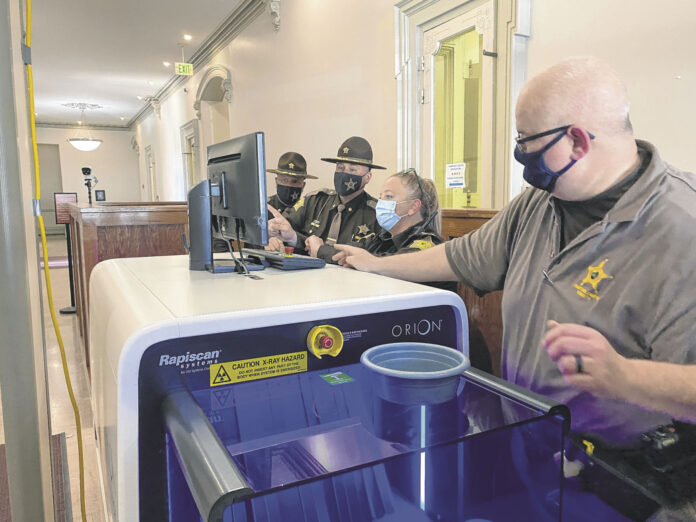
Upgraded security is now at the entrance to the Bartholomew County Courthouse, marking one year since county officials approved the purchase of the X-ray baggage scanner.
“If you come in with a briefcase, a purse or backpack, you put it (on a conveyor belt),” Bartholomew County Jail Commander Maj. John Martoccia said in an earlier interview. “While it goes through, you will still walk through the metal detector.”
One popular feature of the $30,228 scanner is that security personnel no longer have to rummage through purses, suitcases and backpacks unless they see a suspected weapon, Martoccia said. Overall project costs also include an additional $8,000 to replace all glass and aluminum frames to accommodate the new X-ray equipment.
Although judges, court officials and law enforcement say it was a good investment, some still feel more needs to be done to improve courthouse security.
Due to the COVID-19 pandemic, the 147-year-old courthouse was closed to the general public for several months after the decision was made by the county commissioners to buy the scanner. Shortly after the building was reopened to the public last spring, the scanner became operational.
While no weapons of any type are allowed in the building, visitors often forget they may be carrying a potentially lethal item, Chief Deputy Sheriff Maj. Chris Lane said.
On the first day the scanner was operational, it detected an ammunition storage and feeding device for a repeating firearm, as well as a knife inside a handbag. During the second day, a razor blade was confiscated. On the third day, deputies found a “credit card knife,” which is described as similar to a small pocket knife that is marketed as a “survival tool.”
“Today, it is not unusual for us to confiscate three credit card knives and three pocket knives every week,” Lane said.
The special deputies at the courthouse entrance have also found magazines holding rounds of bullets, security officer Rick Swayze said.
Perhaps the most unusual items being carried by a civilian that was detected by the scanner was a set of handcuffs, security officer Maurice Holman added.
Since there isn’t a location to keep these items, security officers ask the owner to take anything prohibited to their car or home before entering the building, which can make individuals late to a court hearing.
A number of criminal hearings are now conducted through video conferencing between the jail and the courtroom. However, the greatest risk of courthouse violence stems from hearings regarding domestic violence, sexual assault or stalking incidents, according to the Center for Courtroom Renovation’s website.
Emotions can also run high in hotly-disputed divorce, child custody cases, child abuse or neglect cases that might lead to violence.
“If we are told to expect a potential injury or someone trying to bring a weapon in, it’s usually some type of family (dispute),” Swayze said.
Besides the scanner and metal detector, Swayze and Holman have another tool, monitors displaying images from more than two dozen security cameras that can all be viewed at the same time.
“But we still have blind spots, so I think we need more cameras,” Swayze said.
A holding room is currently under construction off the Bartholomew Circuit courtroom designed to help keep victims from facing defendants for a lengthy period of time, as well as to allow lawyers and clients to have private consultations, Lane said.
While technology greatly contributes to improved security, the best way to keep the courthouse safe is having people present who can quickly respond, Lane said. The mere presence of a uniformed officer is the greatest deterrent to courthouse violence, he said.
The county’s 2022 budget calls for hiring an additional security officer, but two special deputies are required at the entrance because one will still need to stay at the main security station if the other is called away to address a problem, Lane said.
Therefore, an established goal of having a uniformed officer patrolling every floor will still not be met until another special deputy is hired, he said.




